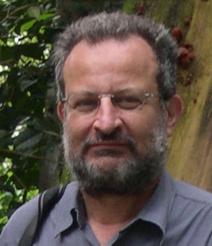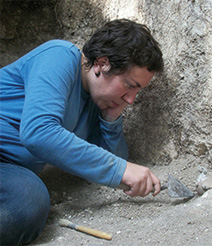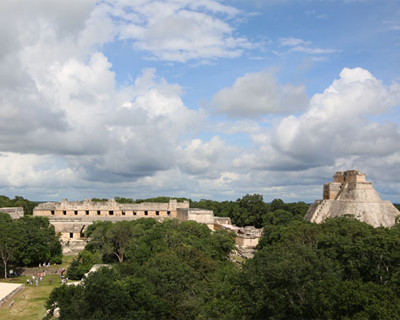ArsUxmal
OTR2022-2348COLAB; OTR2024-24811COLAB; OTR2024-25653COLAB
The Grupo de las Columnas is one of the many urban complexes in Uxmal, which became one of the most important centres of power in the northern Maya Lowlands during the Classic period.
Its strategic location at the heart of the city, situated between the impressive Nunnery Quadrangle to the northeast and the Cemetery Group to the southwest, suggests that the buildings in this area held significant importance for the people who lived in Uxmal in ancient times. This might be why this group has already attracted the attention of three of the main scholars of the Puuc style: Pollock (1980: 224–230), Gendrop (1983:150) and Andrews (1986: 31). However, the typology and function of these buildings remain unknown due to the fact that they are still buried under collapsed building materials, earth and vegetation.
The morphological analysis of the site and the architectural elements that are currently visible suggest that the complex consists of a main building and other outbuildings erected during the Early Puuc period. This period corresponds to the beginning of Uxmal’s heydey and its study is fundamental for understanding key moments in the city’s history and also for analysing the origin and development of the Puuc style, one of the most emblematic and high-quality styles in Maya architecture. It should also be noted that there are very few architectural remains from this period in Uxmal, which increases the importance and interest of excavating this complex.
In addition to determining the purpose of the Grupo de las Columnas buildings and obtaining information on their other uses and significance, the archaeological and architectural investigation of these buildings will facilitate the reconstruction of the sequence of occupation and construction of this urban complex within the city and the Puuc region as a whole.
Ultimately, the comprehensive archaeological excavation of the buildings will facilitate an analysis of their current state of conservation, the formulation of intervention strategies to guarantee their proper preservation and the implementation of consolidation or, when necessary, restoration measures. Furthermore, once the buildings have undergone consolidation, they may be integrated into the archaeological site’s circuit, thereby enhancing the visitor experience by showcasing early examples of Puuc architecture.
archaeology, art, cultural heritage, Maya people, Mexico
- Vidal Lorenzo, Cristina
- PDI-Catedratic/a d'Universitat
 |
Universitat Politècnica de València |
- Vazquez De Agredos Pascual, Maria Luisa
- PDI-Titular d'Universitat
- Conservador/a del Patrimoni Artistic
- Parpal Cabanes, Esther
- PI-Postd_Conselleria_Ant.Apostd2022
 |
Patricia Horcajada Campos | Complutense University of Madrid |
- Feliu Beltran, Nuria
- PDI-Ajudant Doctor/A
- Coordinador/a de Mobilitat
- Garcia Lopez De Andujar, Vanesa
- PI-Invest Formacio Predoc Ministeri
Faculty of Geography and History
Universitat de València
Av. Blasco Ibáñez, 28
46010 València
Phone number: +34 963 864 241
Archaeological site of Uxmal. Instituto Nacional de Antropología e Historia de México (INAH) Yucatán
The main results expected from the project are:
1. Archaeological investigation of the unexplored areas in Uxmal
Conduct archaeological research in the unexplored areas of Uxmal, especially in those areas that are likely to contain buildings from the earliest periods of the city’s history and which are the least known. Among this areas is the Grupo de las Columnas, one of whose partially visible buildings indidicates that it belongs to the Early Puuc style.
The results obtained will be used to: i) investigate the diffusion of Puuc architectural style in the region, since Uxmal was presumably the centre where it originated and spread; ii) deepen our knowledge of the social structure that prevailed in the Puuc Route, an area whose economic and political power was based in Uxmal, according to our initial hypothesis; and iii) contribute to the reconstruction of its dynastic history, which is little known, but which undoubtedly had powerful rulers, given the enormous amount of work invested in the construction of its main buildings and the social complexity required for their planning and execution.
2. Research using new systems of analysis and application of new technologies to the excavation and enhancement of these areas
Implementing, for the first time in the Puuc area, the use of new systems to analyse the buildings and digital technologies throughout the excavation process, through the use of 3D scanners and photogrammetry. This initiative was introduced in the Maya area by the applicant team during the excavations at the archaeological site of La Blanca (Guatemala) with highly satisfactory results.
3. Scientific and dissemination publications by participants in this international project
Disseminate the results of the project both to the scientific community through participation in international congresses and publications in specialist journals and publishers, and to the general public through various means of dissemination, including the design of a website exclusively for this project and the creation of profiles in social networks.
4. International cooperation in the academic field through the participation of Spanish and Mexican professors and students in research activities
Given that the project is being developed within the cooperation agreement signed in May 2021 between the Mexican Secretariat of Culture and the Universitat de València, whose main objective is to promote joint activities in the field of cultural heritage and, in particular, architecture, archaeology and art, the aim is to promote the exchange of researchers, professionals and specialists in order to encourage international research and the mutual provision of assistance, as well as the other activities listed in Article III of this agreement (see sections ‘Institución con la que se colabora en el país de acogida’ and ‘Permiso oficial del proyecto).













